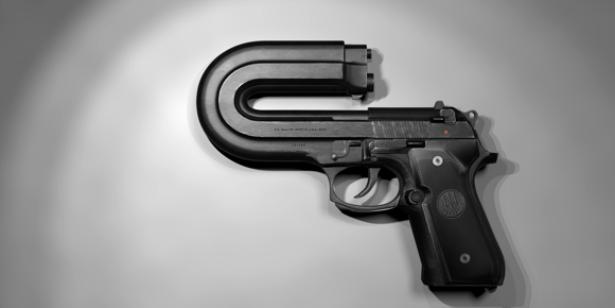As a big fan of authors like Adam Hochschild and Laura Hillenbrand, I’m always impressed with writers who can write about history in a riveting, colorful way. So many of the history books I read in high school and college were lifeless, tedious marches through events, places, and dates. But the best modern nonfiction writers like Hillenbrand and Hochschild make history feel fresh, vibrant, and relevant.
Adam Winkler’s The Secret History of Guns” from the September 2011 issue of The Atlantic is another fine example of a longform article that reveals history in a fresh, engaging way.

Artwork by Joseph Durning/Durning 3D
The politics of guns and gun control have been debated endlessly in newspapers and magazines over the years, but there has been much less written about the history of the issue. Winkler’s story is a surprising bit of history that shows how much the ideology behind guns and regulations have reversed dramatically over the years. And he tells that history with a keen sense of narrative.
For starters he opens with a scene that seem almost inconceivable today:
THE EIGHTH-GRADE STUDENTS gathering on the west lawn of the state capitol in Sacramento were planning to lunch on fried chicken with California’s new governor, Ronald Reagan, and then tour the granite building constructed a century earlier to resemble the nation’s Capitol. But the festivities were interrupted by the arrival of 30 young black men and women carrying .357 Magnums, 12-gauge shotguns, and .45-caliber pistols.
The 24 men and six women climbed the capitol steps, and one man, Bobby Seale, began to read from a prepared statement. “The American people in general and the black people in particular,” he announced, must “take careful note of the racist California legislature aimed at keeping the black people disarmed and powerless Black people have begged, prayed, petitioned, demonstrated, and everything else to get the racist power structure of America to right the wrongs which have historically been perpetuated against black people The time has come for black people to arm themselves against this terror before it is too late.”
Seale then turned to the others. “All right, brothers, come on. We’re going inside.” He opened the door, and the radicals walked straight into the state’s most important government building, loaded guns in hand. No metal detectors stood in their way.
Not only is this a gripping bit of history, framed with some nice details (the kids getting ready to eat with Governor Reagan, the specific firearms the Panthers arrived with, and the fact that there was no metal detector at the entrance of the state capitol in 1967), but it’s written with a cinematic appreciation for the symbolic importance of a moment. It doesn’t hurt that Bobby Seale was a great character with a talent for the dramatic.
Winkler also leave the reader stunned, dying to know what happened next. It’s a fine use of dramatic tension.
This scene serves as a launching point to explore the constitutional issues that have shaped gun rights and regulations since the birth of the nation, and why, until more modern times, the left was often the side pushing for guns rights, while the right often fought to restrict them.
To illustrate this, Winkler recreates another scene in which Huey Newton, one of the Black Panther leaders, has an armed confrontation with a police officer:
“Who in the hell do you think you are?” an officer responded.
“Who in the hell do you think you are?,” Newton replied indignantly. He told the officer that he and his friends had a legal right to have their firearms.
Newton got out of the car, still holding his rifle.
“What are you going to do with that gun?” asked one of the stunned policemen.
“What are you going to do with your gun?,” Newton replied.
By this time, the scene had drawn a crowd of onlookers. An officer told the bystanders to move on, but Newton shouted at them to stay. California law, he yelled, gave civilians a right to observe a police officer making an arrest, so long as they didn’t interfere. Newton played it up for the crowd. In a loud voice, he told the police officers, “If you try to shoot at me or if you try to take this gun, I’m going to shoot back at you, swine.”
This scene isn’t just for the sake of drama. Winkler goes on to demonstrate how the arguments and the ideology of the Black Panthers will later be embraced and appropriated by the modern gun rights lobby. What was the rhetoric of the radical left in the 1960s becomes the arguments of mainstream conservatives today.
The story isn’t all dramatic moments like this; in fact, the majority of the piece is a methodical look at the history of gun laws in America from colonial times to present day. It challenges readers to drop their assumptions as to who stood on which side of gun laws. White Southerners sought to restrict gun rights in the reconstruction-era South, while freed slaves argued for Second Amendment rights. The National Rifle Association — yes, the N-fucking-R-A — supported gun registration and restrictions in the 1930s. Ronald Reagan fought for gun control at a time when the Black Panthers opposed it.
Start-to-finish, this is a great read and a surprising look at the history of gun control in America.